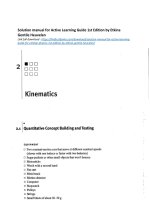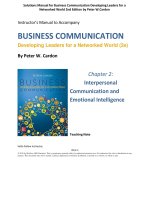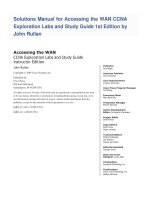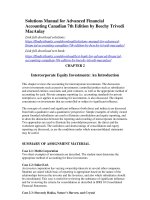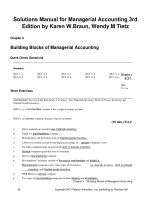lin download solutions manual for accessing the WAN CCNA exploration labs and study guide 1st edition by john rullan
Bạn đang xem bản rút gọn của tài liệu. Xem và tải ngay bản đầy đủ của tài liệu tại đây (1.65 MB, 53 trang )
Solutions Manual for Accessing the WAN CCNA
Exploration Labs and Study Guide 1st Edition by
John Rullan
Accessing the WAN
CCNA Exploration Labs and Study Guide
Instructor Edition
John Rullan
Copyright © 2008 Cisco Systems, Inc.
Published by:
Cisco Press
800 East 96th Street
Indianapolis, IN 46240 USA
All rights reserved. No part of this book may be reproduced or transmitted in any form
or by any means, electronic or mechanical, including photocopying, record-ing, or by
any information storage and retrieval system, without written permission from the
publisher, except for the inclusion of brief quotations in a review.
Publisher
Paul Boger
Associate Publisher
Dave Dusthimer
Cisco Representative
Anthony Wolfenden
Cisco Press Program Manager
Jeff Brady
Executive Editor
Mary Beth Ray
Production Manager
Patrick Kanouse
ISBN-13: 978-1-58705-579-9
ISBN-10: 1-58705-579-1
Senior Development
Editor Christopher Cleveland
Project Editor
Seth Kerney
Copy Editors
Keith Cline
Gayle Johnson
Technical Editors
Roderick Douglas
Lee Hilliard
Wayne Jarvimaki
Editorial Assistant
Vanessa Evans
Book and Cover
Designer Louisa Adair
Composition
Bronkella Publishing, Inc.
Proofreaders
Water Crest Publishing, Inc.
Debbie Williams
iii
Warning and Disclaimer
This book is designed to provide information about the Accessing the WAN course of the Cisco
Networking Academy CCNA Exploration curriculum. Every effort has been made to make this book
as complete and accurate as possible, but no warranty or fitness is implied.
The information is provided on an ―as is‖ basis. The authors, Cisco Press and Cisco Systems, Inc. shall have
neither liability nor responsibility to any person or entity with respect to any loss or damages arising from the
information contained in this book or from the use of the discs or programs that may accompany it.
The opinions expressed in this book belong to the authors and are not necessarily those of Cisco
Systems, Inc.
Trademark Acknowledgments
All terms mentioned in this book that are known to be trademarks or service marks have been appropriately capitalized. Cisco Press or Cisco Systems, Inc. cannot attest to the accuracy of this information. Use of
a term in this book should not be regarded as affecting the validity of any trademark or service mark.
Corporate and Government Sales
The publisher offers excellent discounts on this book when ordered in quantity for bulk purchases or special sales, which may include electronic versions and/or custom covers and content particular to your business, training goals, marketing focus, and branding interests. For more information, please contact:
U.S. Corporate and Government Sales
1-800-382-3419
For sales outside the United States please contact:
International Sales
Feedback Information
At Cisco Press, our goal is to create in-depth technical books of the highest quality and value. Each book
is crafted with care and precision, undergoing rigorous development that involves the unique expertise of
members of the professional technical community.
Reader feedback is a natural continuation of this process. If you have any comments about how we could
improve the quality of this book, or otherwise alter it to better suit your needs, you can contact us through email at Please be sure to include the book title and ISBN in your message.
We greatly appreciate your assistance.
8
iv
Accessing the WAN, CCNA Exploration Labs and Study Guide
About the Author
John Rullan has been teaching at Thomas Edison High School in Jamaica, New York for the past
13 years and has been a part of the Cisco Networking Academy since 1998. He is the director of the
Cisco Academy for the New York City Department of Education and is the citywide trainer. He provides support to the academy community and has presented at academy conferences throughout the
country while working on the Instructional Support and Curriculum Maintenance teams. He also has
taught CCNA, CCNP, and network security for the Borough of Manhattan Community College since
2000. He currently holds the Network+, CCNA, CCNP, and CCAI certifications.
About the Contributing Author
Sonya Coker received her undergraduate degree in secondary education from the University of
South Alabama. She worked in the public school system for five years as a Title 1 Project
Coordinator serv-ing at-risk students. She joined the Cisco Academy program in 1998 when she
started a local CCNA Academy at Murphy High School in Mobile, Alabama. She now works as a
full-time developer in the Cisco Networking Academy program. She has worked on a variety of
Academy curriculum projects, including CCNA, CCNP, Fundamentals of Wireless LANs, and
Network Security. She has taught instructor training classes throughout the world.
v
About the Technical Reviewers
Roderick Douglas, Senior Lecturer with the IT Foundry at Sheffield Hallam University in the UK,
has been an active Cisco Certified Academy Instructor since 2002. He is committed to delivering
high-quality, flexible, and innovative training through the Cisco Academy Program. He has an MSc
in computing from Sheffield Hallam University, Sheffield, UK. He holds CCNA and Wireless
certifica-tions from Cisco, as well as Microsoft MCSE/MCT, Novell CNE/CNI/Linux, CompTIA
Linux+, and Security+, CWNA, Wireless# certifications.
Lee Hilliard is a professor and department chair for Computer Networking at College of the Canyons
in Santa Clarita, California. He has been involved in the Cisco Networking Academy program since
2000 and is a CCAI and CATC instructor for CREATE CATC. He has structured the Computer
Networking department to foster a spirit of community involvement by having students work with
local businesses and nonprofit organizations. These efforts include soliciting surplus equipment from
local businesses when they upgrade, having the students in the program refurbish the equipment as
part of their hands-on lab activities, and then redistributing the equipment to nonprofit organizations.
This is a win-win-win situation in which the students get practical application of the skills learned,
the distribution of the equipment to underprivileged youth helps address the ―digital divide,‖ and
keeping usable equipment in service supports a sustainability effort. Hilliard has a master of science
degree in industrial technology from California State University, Fresno.
Wayne Jarvimaki is a Main Contact/Lead Instructor for North Seattle Cisco Area Training Center
(CATC) and has been training instructors in North America and Asia/Pac since 1998. Wayne serves
on the Board of SeaKay, a nonprofit organization that helps Cisco Academies and low-income housing. He is the Senior Network Designer for CNS, a provider of bridged wireless campus networks
for Digital Divide communities, and currently holds CCNA and CCAI certifications.
vi
Accessing the WAN, CCNA Exploration Labs and Study Guide
Dedications
I would like to dedicate this book to all my past and present students, whose dedication has inspired
me to make this book the best that it can be. I would like to give special thanks to Emil Prysak, Alroy
Lam, and Nabil El Bakhar, my current students, and Jalil Khan, a graduate, who still lends a hand
and is always around to help.
—John Rullan
For all the students and instructors who have challenged and inspired me throughout my career in the
Cisco Networking Academy Program. Your enthusiasm and curiosity remind me that there’s always
something new to learn.
—Sonya Coker
vii
Acknowledgments
Sonya Coker, coauthor, for giving me the pleasure of working with her on various support teams. I
couldn’t think of anyone else I would like to write this book with. Her input and lab activities are
sure to make this Study Guide much more educational and challenging.
Mary Beth Ray, executive editor, for allowing me to share my thoughts and ideas and putting them
in this book. She is always there for me and helps keep me on track and on time!
Christopher Cleveland, development editor, for his patience, creativity, and support in making
this book possible.
—John Rullan
Thanks to the Exploration development team for making me a part of the process of creating,
editing, and improving the course that this book has been written to support. Knowing what you
wanted for our students helped set the focus for this Study Guide.
Thanks to Mary Beth Ray and the whole team at Cisco Press for their patience and encouragement.
Thanks Chris Cleveland for bearing with me during my learning curve.
—Sonya Coker
viii Accessing the WAN, CCNA Exploration Labs and Study Guide
Contents at a Glance
Introduction xxi
Chapter 1
Introduction to WANs 1
Chapter 2
PPP
Chapter 3
Frame Relay 115
Chapter 4
Network Security 183
Chapter 5
ACLs
Chapter 6
Teleworker Services
Chapter 7
IP Addressing Services 341
Chapter 8
Network Troubleshooting
Appendix
How to Install SDM 543
49
285
331
407
ix
Contents
Introductionxxi
Chapter 1
Introduction to WANs
1
Providing Integrated Services to the Enterprise 2
Review Question 2
Exercise 1-1: Browsing Through Internet Routing Tables 2
Exercise 1-2: Tracing a Path Through the Internet 4
WAN Technology Concepts
6
Review Question 6
WAN Connection Options 6
Review Questions 7
Chapter Review Vocabulary Exercise: Matching
Chapter Review Multiple-Choice Questions
9
Lab 1-1: Challenge Review Lab (1.4.1)
13
8
Scenario 14
Task 1: Prepare the Network 14
Task 2: Perform Basic Device Configurations 15
Task 3: Configure and Activate Serial and Ethernet Addresses 15
Task 4: Configure STP 18
Task 5: Configure VTP 18
Task 6: Configure VLANs 20
Task 7: Configure RIP Routing 23
Task 8: Configure OSPF Routing 29
Task 9: Configure EIGRP Routing 31
Task 10: Document the Router Configurations
34
Task 11: Clean Up 42
Packet Tracer Exercise: Comprehensive WAN Fundamentals
42 Packet Tracer Skills Integration Challenge 42
Task 1: Configure Static and Default Routing 44
Task 2: Add and Connect the BRANCH Router 45
Task 3: Add and Connect the Switches 45
Task 4: Add and Connect the PCs 45
Task 5: Perform Basic Device Configuration 46
Task 6: Configure OSPF Routing 46
Task 7: Configure STP
47
Task 8: Configure VTP
47
Task 9: Configure Trunking 47
Task 10: Configure VLANs 47
Task 11: Verify End-to-End Connectivity 48
x
Accessing the WAN, CCNA Exploration Labs and Study Guide
Chapter 2
PPP 49
Serial Point-to-Point Links
50
Review Questions 51
PPP Concepts 51
Vocabulary Exercise: Matching 52
Configuring PPP 53
Review Questions 53
Configuring PPP with Authentication 53
Review Questions 54
Chapter Review: Multiple-Choice Questions
54
Chapter Review Exercise 58
Lab 2-1: Basic PPP Configuration Lab (2.5.1)
59
Scenario 60
Task 1: Prepare the Network 60
Task 2: Perform Basic Router Configuration 60
Task 3: Configure and Activate Serial and Ethernet Addresses 61
Task 4: Configure OSPF on the Routers
63
Task 5: Configure PPP Encapsulation on Serial Interfaces 65
Task 6: Break and Restore PPP Encapsulation 71
Task 7: Configure PPP Authentication 72
Task 8: Intentionally Break and Restore PPP CHAP Authentication 76
Task 9: Document the Router Configurations 78
Task 10: Clean Up 81
Packet Tracer Companion: Basic PPP Configuration (2.5.1) 81
Lab 2-2: Challenge PPP Configuration (2.5.2) 82
Scenario 83
Task 1: Prepare the Network 83
Task 2: Perform Basic Router Configuration 83
Task 3: Configure and Activate Serial and Ethernet Addresses 84
Task 4: Configure OSPF on Routers 86
Task 5: Configure PPP Encapsulation on Serial Interfaces 88
Task 6: Intentionally Break and Restore PPP Encapsulation 90
Task 7: Configure PPP CHAP Authentication 91
Task 8: Intentionally Break and Restore PPP CHAP Authentication 92
Task 9: Document the Router Configurations 93
Task 10: Clean Up 97
Packet Tracer Companion: Challenge PPP Configuration (2.5.2) 97
Lab 2-3: Troubleshooting PPP Configuration (2.5.3) 98
Scenario 99
Task 1: Load Routers with the Supplied Scripts 99
Task 2: Find and Correct Network Errors 105
xi
Task 3: Document the Corrected Network 105
Task 4: Clean Up 109
Packet Tracer Companion: Troubleshooting PPP Configuration (2.5.3)
Packet Tracer Exercise 2-1: PPP
109
Packet Tracer Exercise 2-2: PPP Troubleshooting 109
Packet Tracer Skills Integration Challenge 109
Task 1: Configure Static and Default Routing 111
Task 2: Add and Connect a Router 111
Task 3: Design and Document an Addressing Scheme 111
Task 4: Add and Connect the Devices in the Address Space 112
Task 5: Configure Basic Device Settings 112
Task 6: Configure PPP Encapsulation with CHAP Authentication 113
Task 7: Configure OSPF Routing 113
Task 8: Configure VLANs 114
Task 9: Verify Connectivity 114
Chapter 3
Frame Relay 115
Basic Frame Relay Concepts 116
Review Questions 117
Configuring Frame Relay
117
Vocabulary Exercise: Matching Terms 118
Advanced Frame Relay Concepts
118
Fill-in-the-Blank Exercise 119
Configuring Advanced Frame Relay 119
Vocabulary Exercise: Matching Commands 120
Chapter Review Multiple-Choice Questions 122
Lab 3-1: Basic Frame Relay (3.5.1) 126
Scenario 127
Task 1: Prepare the Network 127
Task 2: Perform Basic Router Configuration 128
Task 3: Configure Frame Relay 129
Task 4: Verify the Configuration 134
Task 5: Troubleshoot Frame Relay 138
Task 6: Configure a Frame Relay Subinterface 143
Final Configurations 149
Lab 3-2: Challenge Frame Relay Configuration (3.5.2)
Scenario 153
Task 1: Prepare the Network 153
Task 2: Perform Basic Router Configuration 153
Task 3: Configure IP Addresses 153
Task 4: Configure EIGRP on Routers R1 and R2 154
152
109
xii
Accessing the WAN, CCNA Exploration Labs and Study Guide
Task 5: Configure Frame Relay PVC Between R1 and R2 154
Task 6: Intentionally Break the PVC, and Then Restore It 155
Task 7: Configure Frame Relay Subinterfaces 155
Task 8: Intentionally Break the PVC, and Then Restore It 156
Task 9: Document the Router Configurations 156
Task 10: Clean Up 156
Lab 3-3: Troubleshooting Frame Relay (3.5.3)
156
Scenario 157
Task 1: Prepare the Network 157
Task 2: Troubleshoot and Repair the Frame Relay Connection Between
R1 and R2 162
Task 3: Document the Router Configurations 162
Task 4: Clean Up 162
Lab 3-4: Frame Relay with Subinterfaces
162
Scenario 164
Task 1: Configure the HQ Router 164
Task 2: Configure Subinterfaces on the HQ Router 164
Task 3: Configure the Serial Interface on the Branch 1 Router 165
Task 4: Configure the Serial Interface on the Branch 2 Router 165
Task 5: Configure the Serial Interface on the Branch 3 Router 165
Task 6: Configure the FastEthernet Interface on the Branch 1 LAN 166
Task 7: Configure the FastEthernet Interface on the Branch 2 LAN 166
Task 8: Configure the FastEthernet Interface on the Branch 3 LAN 166
Task 9: Configure EIGRP 166
Task 10: Verify the Configurations 167
Packet Tracer Companion: Frame Relay Full Mesh 174
Packet Tracer Skills Integration Challenge 174
Task 1: Configure PPP with CHAP Between Devices 176
Task 2: Configure Full-Mesh Frame Relay 177
Task 3: Configure Static and Default Routing 178
Task 4: Configure and Test Inter-VLAN Routing 179
Task 5: Configure VTP and Trunking on the Switches 179
Task 6: Configure VLANs on the Switch 180
Task 7: Configure and Verify VLAN 99 181
Task 8: Configure S1 as Root for All Spanning Trees 181
Task 9: Assign Ports to VLANs 182
Task 10: Test End-to-End Connectivity 182
xiii
Chapter 4
Network Security 183
Introduction to Network Security
184
Vocabulary Exercise: Matching 184
Vocabulary Exercise: Completion 185
Securing Cisco Routers 186
Describe Good Password Practices 186
Configuring Router Passwords 186
Secure Router Network Services
187
Vulnerable Router Services Exercise 188
Securing Routing Protocols: Completion 188
Using Cisco Security Device Manager
189
Preparing a Router for SDM 189
Secure Router Management 190
Managing Cisco IOS Images: Identify Commands 190
Managing Cisco IOS Images: Short Answer 190
Password-Recovery Exercise 191
Lab 4-1: Basic Security Configuration (4.6.1) 193
Scenario
193
Task 1: Prepare the Network 195
Task 2: Perform Basic Router Configurations 195
Task 3: Secure the Router from Unauthorized Access 195
Task 4: Secure Access to the Network 198
Task 5: Logging Activity with SNMP (Simple Network Management
Protocol) 201
Task 6: Disabling Unused Cisco Network Services 202
Task 7: Managing Cisco IOS and Configuration Files 208
Task 8: Using SDM to Secure a Router 223
Task 9: Document the Router Configurations 230
Task 10: Clean Up 238
Lab 4-2: Challenge Security Configuration (4.6.2)
238
Scenario 238
Task 1: Prepare the Network 240
Task 2: Perform Basic Router Configurations 240
Task 3: Secure Access to Routers 240
Task 4: Secure Access to the Network 242
Task 5: Logging Activity with SNMP (Simple Network Management
Protocol) 244
Task 6: Disabling Unused Cisco Network Services 244
Task 7: Managing Cisco IOS and Configuration Files 251
Task 8: Using SDM to Secure R2 252
Task 9: Document the Router Configurations 253
Task 10: Clean Up 261
xiv
Accessing the WAN, CCNA Exploration Labs and Study Guide
Lab 4-3: Troubleshooting Security Configuration (4.6.3)
Scenario
262
Task 1: Load Routers with the Supplied Scripts 263
Task 2: Find and Correct All Network Errors 274
Task 3: Document the Corrected Network 274
Task 4: Clean Up 282
Packet Tracer Skills Integration Challenge 283
Task 1: Configure Routing 284
Task 2: Configure OSPF Authentication 284
Task 3: Upgrade the Cisco IOS Image 284
Chapter 5
ACLs
285
Using ACLs to Secure Networks
286
Multiple-Choice Questions 287
Configuring Standard ACLs: Command Exercise
289
Configuring Extended ACLs 291
Vocabulary Exercise: Matching Terms 291
Extended ACL Command Exercise 292
Configuring Complex ACLs
293
Review Questions 293
Vocabulary Exercise: Matching Terms 294
Lab 5-1: Basic Access Control Lists (5.5.1)
295
Scenario 296
Task 1: Prepare the Network 296
Task 2: Perform Basic Router Configurations 296
Task 3: Configure a Standard ACL 300
Task 4: Configure an Extended ACL 302
Task 5: Control Access to the VTY Lines with a Standard ACL 303
Task 6: Troubleshoot ACLs 304
Task 7: Document the Router Configurations 305
Task 8: Clean Up 308
Packet Tracer Companion: Basic Access Control Lists (5.5.1) 308
Lab 5-2: Access Control Lists Challenge (5.5.2)
309
Task 1: Prepare the Network 310
Task 2: Perform Basic Router Configurations 310
Task 3: Configure Standard ACLs 312
Task 4: Configure Extended ACLs 313
Task 5: Verify an ACL 314
Task 6: Document the Router Configurations 315
Task 7: Clean Up 318
Packet Tracer Companion: Challenge Access Control Lists (5.5.2) 318
262
xv
Lab 5-3: Troubleshooting Access Control Lists (5.5.3)
Scenario 319
Task 1: Load Routers with the Supplied Scripts 319
Task 2: Find and Correct Network Errors 322
Task 3: Document the Corrected Network 322
Task 4: Clean Up 324
Packet Tracer Exercise 5.1: Named Access Control Lists 325
Packet Tracer Exercise 5.2: Access Control Lists 325
Packet Tracer Skills Integration Challenge 325
Introduction 326
Task 1: Configure PPP with CHAP Authentication 326
Task 2: Configure Default Routing 327
Task 3: Configure OSPF Routing 327
Task 4: Implement Multiple ACL Security Policies 328
Chapter 6
Teleworker Services
331
Business Requirements for Teleworker Services
332
Review Questions 332
Broadband Services: Fill-in-the-Blank Exercise 333
VPN Technology 334
Vocabulary Exercise: Matching 334
Multiple-Choice Questions 335
Packet Tracer Exercise 6-1: DSL/Cable Configuration
Packet Tracer Exercise 6-2: Wireless Configuration
337
337
Packet Tracer Skills Integration Challenge 337
Task 1: Apply Basic Router Configurations
339
Task 2: Configure Dynamic and Default Routing 339
Task 3: Establish Teleworker Services 339
Task 4: Test Connectivity Before ACL Configuration 340
Task 5: Apply ACL Policies 340
Task 6: Test Connectivity After ACL Configuration
Chapter 7
IP Addressing Services 341
DHCP 342
Vocabulary Exercise: Matching 342
Scaling Networks with NAT
343
Fill-in-the-Blank Exercise 343
Vocabulary Exercise: Matching 344
Reasons for Using IPv6
344
Multiple-Choice Questions 345
Concept Questions 348
340
318
xvi
Accessing the WAN, CCNA Exploration Labs and Study Guide
Lab 7-1: Basic DHCP and NAT Configuration (7.4.1) 349
Scenario 350
Task 1: Prepare the Network 350
Task 2: Perform Basic Router Configurations 350
Task 3: Configure PC1 and PC2 to Receive an IP Address Through DHCP 352
Task 4: Configure a Cisco IOS DHCP Server 353
Task 5: Configure Static and Default Routing 356
Task 6: Configure Static NAT 357
Task 7: Configure Dynamic NAT with a Pool of Addresses 357
Task 8: Configure NAT Overload 359
Task 9: Document the Network 360
Task 10: Clean Up 364
Packet Tracer Companion: Basic DHCP and NAT Configuration (7.4.1) 364
Lab 7-2: Challenge DHCP and NAT Configuration (7.4.2)
Scenario 366
Task 1: Prepare the Network 366
Task 2: Perform Basic Router Configurations 366
Task 3: Configure a Cisco IOS DHCP Server 368
Task 4: Configure Static and Default Routing 368
Task 5: Configure Static NAT 369
Task 6: Configure Dynamic NAT with a Pool of Addresses 369
Task 7: Document the Network 369
Task 8: Clean Up 369
Packet Tracer Companion: Challenge DHCP and NAT
Configuration (7.4.2) 373
Lab 7-3: Troubleshooting DHCP and NAT (7.4.3)
373
Scenario 374
Task 1: Prepare the Network 374
Task 2: Find and Correct Network Errors 377
Task 3: Document the Router Configurations 378
Task 4: Clean Up 378
Final Configurations 378
Packet Tracer Companion: Troubleshooting DHCP and NAT
Configuration (7.4.3) 381
Lab 7-4: IPv6 Basic Configuration Using an Adtran
Scenario 381
Task 1: Upgrade IOS to Support IPv6 382
Task 2: Enter Basic Configuration for Each Device 382
Task 3: Enable IPv6 Forwarding 383
Task 4: Configure IPv6 Addresses
384
Task 5: Create and Address Loopbacks 385
381
365
xvii
Task 6: Configure RIPng Routing 386
Task 7: Test Connectivity 388
Lab 7-5: IPv6 Basic Configuration Using a Frame Switch
389
Scenario 389
Task 1: Upgrade IOS to Support IPv6 389
Task 2: Enter the Basic Configuration for Each Device 390
Task 3: Enable IPv6 Forwarding 391
Task 4: Configure IPv6 Addresses
392
Task 5: Create and Address Loopbacks 393
Task 6: Configure RIPng Routing 395
Task 7: Test Connectivity 399
Task 8: Advertise the Default Route 399
Packet Tracer Exercise 7-1: DHCP
400
Packet Tracer Exercise 7-2: DHCP Troubleshooting
400
Packet Tracer Exercise 7-3: Configuring NAT, PAT, and Static NAT
Packet Tracer Exercise 7-4: Double NAT with DHCP
400 Packet Tracer Skills Integration Challenge 400
Task 1: Apply Basic Configurations 402
Task 2: Configure PPP Encapsulation with CHAP 402
Task 3: Configure Dynamic and Default Routing 403
Task 4: Configure Routers Using DHCP 403
Task 5: Verify That PCs Are Automatically Configured with Addressing
Details 404
Task 6: Configure a DNS Server with DNS Entries 404
Task 7: Configure an ACL to Permit NAT 404
Task 8: Configure Static NAT 405
Task 9: Configure Dynamic NAT with Overload 405
Task 10: Configure the ISP Router with a Static Route 405
Task 11: Test Connectivity 405
Chapter 8
Network Troubleshooting 407
Documenting Your Network 408
Concept Questions
408
Troubleshooting Methodologies and Tools 409
Multiple-Choice Questions 410
WAN Communications
411
Fill-in-the-Blank Exercise 412
Network Troubleshooting
412
Vocabulary Exercise: Define 413
Activity 8-1: Troubleshooting Role Play (8.3.7)
Scenario
414
Task 1: Build the Network 415
414
400
xviii
Accessing the WAN, CCNA Exploration Labs and Study Guide
Task 2: Test the Network
415
Task 3: Break the Network
415
Task 4: Troubleshoot the Problem 415
Task 5: Gather Symptoms from Suspect Devices
415
Task 6: Correct the Problem 415
Task 7: Document the Problem and Solution 415
Task 8: Reverse the Roles and Start Over 415
Task 9: Clean Up
415
Lab 8-1: Troubleshooting Enterprise Networks 1 (8.5.1)
416
Scenario 417
Task 1: Load Routers with the Supplied Scripts 418
Task 2: Find and Correct All Network Errors 431
Task 3: Verify That Requirements Are Fully Met 431
Task 4: Document the Corrected Network 432
Task 5: Clean Up 445
Alternate Configurations 445
Packet Tracer Companion: Troubleshooting Enterprise Networks 1 (8.5.1) 457
Lab 8-2: Troubleshooting Enterprise Networks 2 (8.5.2)
458
Scenario 459
Task 1: Load Routers with the Supplied Scripts 460
Task 2: Find and Correct All Network Errors 473
Task 3: Verify That Requirements Are Fully Met 473
Task 4: Document the Corrected Network 474
Task 5: Clean Up 485
Packet Tracer Companion: Troubleshooting Enterprise Networks 2 (8.5.2) 485
Lab 8-3: Troubleshooting Enterprise Networks 3 (8.5.3)
486
Scenario 487
Task 1: Load Routers with the Supplied Scripts 488
Task 2: Find and Correct All Network Errors 500
Task 3: Verify That Requirements Are Fully Met 500
Task 4: Document the Corrected Network 501
Task 5: Clean Up 512
Packet Tracer Companion: Troubleshooting Enterprise Networks 3 (8.5.3) 512
Packet Tracer Exercise 8-1: Comprehensive Network Troubleshooting
513 Packet Tracer Skills Integration Challenge 513
Task 1: Configure Frame Relay in a Hub-and-Spoke Topology 515
Task 2: Configure PPP with CHAP and PAP Authentication 519
Task 3: Configure Static and Dynamic NAT on HQ 520
Task 4: Configure Static and Default Routing 521
Task 5: Configure Inter-VLAN Routing 522
Task 6: Configure and Optimize EIGRP Routing 523
xix
Task 7: Configure VTP, Trunking, the VLAN Interface, and VLANs 526
Task 8: Assign VLANs and Configure Port Security 530
Task 9: Configure STP 532
Task 10: Configure DHCP 533
Task 11: Configure a Firewall ACL 536
Task 12: Configure Wireless Connectivity 537
Task 13: Network Troubleshooting 542
How to Install SDM
543
Step 1: Preparation
543
Step 2: Prepare the Router for SDM 543
Step 3: Configure Addressing 544
Step 4: Extract SDM on the Host 544
Step 5: Install SDM on the PC 544
Step 6: Run SDM from the PC 545
Step 7: Install SDM to the Router 547
Step 8: Run SDM from the Router 549
xx
Accessing the WAN, CCNA Exploration Labs and Study Guide
Icons Used in This Book
Router
Switch
Wireless Connection
PC
Wireless
Router
Line: Ethernet
Line: Serial
Server
Network Cloud
Command Syntax Conventions
The conventions used to present command syntax in this book are the same conventions used in the
IOS Command Reference. The Command Reference describes these conventions as follows:
Bold indicates commands and keywords that are entered literally as shown. In actual configuration examples and output (not general command syntax), bold indicates commands that the user
enters (such as a show command).
Italic indicates arguments for which you supply actual values.
Vertical bars (|) separate alternative, mutually exclusive elements.
Square brackets ([ ]) indicate an optional element.
Braces ({ }) indicate a required choice.
Braces within brackets ([{ }]) indicate a required choice within an optional element.
xxi
Introduction
The Cisco Networking Academy is a comprehensive e-learning program that provides students with
Internet technology skills. A Networking Academy delivers web-based content, online assessment,
student performance tracking, and hands-on labs to prepare students for industry-standard certifications. The CCNA curriculum includes four courses oriented around the topics on the Cisco
Certified Network Associate (CCNA) certification.
Accessing the WAN, CCNA Exploration Labs and Study Guide is a supplement to your classroom and
laboratory experience with the Cisco Networking Academy. To succeed on the exam and achieve
your CCNA certification, you should do everything in your power to arm yourself with a variety of
tools and training materials to support your learning efforts. This Labs and Study Guide is just such a
col-lection of tools. Used to its fullest extent, it will help you acquire the knowledge and practice the
skills associated with the content area of the CCNA Exploration Accessing the WAN course.
Specifically, this book helps you work on these main areas:
WAN technology concepts
PPP concepts and configuration
Frame Relay concepts and configuration
Network security threats and mitigation techniques
Access control list operation and configuration
Broadband services and technologies
Network Address Translation concepts and configuration
DHCP operation and configuration
IPv6 concepts
Troubleshooting methodologies and tools
Labs and Study Guides similar to this one are also available for the other three courses: Network
Fundamentals, CCNA Exploration Labs and Study Guide; Routing Protocols and Concepts, CCNA
Exploration Labs and Study Guide; and LAN Switching and Wireless, CCNA Exploration Labs and
Study Guide.
Audience for This Book
This book's main audience is anyone taking the CCNA Exploration Accessing the WAN course of
the Cisco Networking Academy curriculum. Many Academies use this book as a required tool in the
course, and other Academies recommend the Labs and Study Guides as an additional source of study
and practice materials.
Goals and Methods
The most important goal of this book is to help you pass the CCNA exam (640-802). Passing this
foundation exam means that you not only have the required knowledge of the technologies covered
by the exam, but that you can plan, design, implement, operate, and troubleshoot these technologies.
In other words, these exams are rigorously application-based. You can view the exam topics any time
at The topics are divided into eight categories:
xxii
Accessing the WAN, CCNA Exploration Labs and Study Guide
Describe how a network works
Configure, verify, and troubleshoot a switch with VLANs and interswitch communications
Implement an IP addressing scheme and IP Services to meet network requirements in
a medium-size Enterprise branch office network
Configure, verify, and troubleshoot basic router operation and routing on Cisco devices
Explain and select the appropriate administrative tasks required for a WLAN
Identify security threats to a network, and describe general methods to mitigate those threats
Implement, verify, and troubleshoot NAT and ACLs in a medium-size Enterprise branch
office network
Implement and verify WAN links
The Accessing the WAN course focuses on the third, fifth, sixth, seventh, and eighth topics.
The Study Guide portion of each chapter offers exercises that help you learn the Accessing the WAN
concepts as well as the configurations crucial to your success as a CCNA exam candidate. Each
chap-ter is slightly different and includes some or all of the following types of exercises:
Vocabulary matching and completion
Skill-building activities and scenarios
Configuration scenarios
Concept questions
Internet research
Packet Tracer
Activity
In the configuration chapters, you’ll find many Packet Tracer Activities that work with the Cisco
Packet Tracer tool. Packet Tracer allows you to create networks, visualize how packets flow in the
net-work, and use basic testing tools to determine whether the network would work. When you see
this icon, you can use Packet Tracer with the listed file to perform a task suggested in this book. The
activ-ity files are available on this book’s CD-ROM; Packet Tracer software, however, is available
through the Academy Connection website. Ask your instructor for access to Packet Tracer.
The Labs and Activities portion of each chapter includes all the online Curriculum Labs, some additional supplemental labs that you can perform with Packet Tracer, and a Packet Tracer Skills
Integration Challenge Activity. The Curriculum Labs are divided into three categories:
Basic: The Basic Labs are procedural in nature and assume that you have no experience configuring the technologies that are the topic of the lab.
Challenge: The Challenge Labs cover implementations and assume that you have a firmenough grasp on the technologies to ―go it alone.‖ These labs often give you only a general
requirement that you must implement fully without the details of each small step. In other
words, you must use the knowledge and skills you gained in the chapter text, activities, and
Basic Lab to successfully complete the Challenge Lab. Avoid the temptation to work through
the Challenge Lab by flipping back through the Basic Lab when you are unsure of a
command. Do not try to short-circuit your CCNA training. You need a deep understanding of
CCNA knowledge and skills to ultimately be successful on the CCNA exam.
Troubleshooting: The Troubleshooting Labs ask you to fix a broken network. These labs
include corrupted scripts that you purposely load onto the routers. Then you use troubleshooting techniques to isolate problems and implement the solution. By the end of the lab, you
should have a functional network with full end-to-end connectivity.
xxiii
Packet Tracer
Companion
Packet Tracer
Challenge
Most of the Hands-on Labs include Packet Tracer Companion Activities, in which you can use
Packet Tracer to complete a simulation of the lab.
Each chapter ends with a Packet Tracer Skills Integration Challenge. These activities require you
to pull together several skills learned from the chapter—as well as previous chapters and courses—
to successfully complete one comprehensive exercise.
A Word About Packet Tracer
Packet Tracer is a self-paced, visual, interactive teaching and learning tool developed by Cisco. Lab
activities are an important part of networking education. However, lab equipment can be a scarce
resource. Packet Tracer provides a visual simulation of equipment and network processes to offset the
challenge of limited equipment. Students can spend as much time as they like completing standard lab
exercises through Packet Tracer, and they have the option to work from home. Although Packet Tracer
is not a substitute for real equipment, it allows students to practice using a command-line interface.
This ―e-doing‖ capability is a fundamental component of learning how to configure routers and
switches from the command line.
Packet Tracer version 4.x is available only to Cisco Networking Academies through the
Academy Connection website.
How This Book Is Organized
Because the content of this book and the online curriculum is sequential, you should work through
this book in order, beginning with Chapter 1.
The book covers the major topic headings in the same sequence as the online curriculum for the
CCNA Exploration Accessing the WAN course. This book has eight chapters with the same
numbers and names as the online course chapters.
If necessary, a chapter uses a single topology for the exercises in the Study Guide portion. This
single topology allows for better continuity and easier understanding of switching commands,
operations, and outputs. However, the topology is different from the one used in the online
curriculum and the Companion Guide. A different topology affords you the opportunity to practice
your knowledge and skills without just simply recording the information you find in the text.
Chapter 1, “Introduction to WANs”: The exercises in the Study Guide portion of this
chapter focus on LAN design concepts, including vocabulary and the three-layer hierarchical
model. The Lab portion of the chapter includes a Basic Lab, a Challenge Lab, a
Troubleshooting Lab, and a Packet Tracer Skills Integration Challenge activity.
Chapter 2, “PPP”: The exercises in the first part of this chapter help you understand basic
Ethernet and switching concepts, including building the MAC address table and collision and
broadcast domains. Then the Packet Tracer exercises cover, in detail, how to configure a
switch, including basic switch management and configuring switch security. The Lab portion of
the chapter includes two Basic Labs, a Challenge Lab, and a Packet Tracer Skills Integration
Challenge activity.
xxiv
Accessing the WAN, CCNA Exploration Labs and Study Guide
Chapter 3, “Frame Relay”: The exercises in the first portion of this chapter focus on the con-cepts
of VLANs, including benefits of VLANs and types of VLANs. The exercises then cover VLAN
trunking concepts before moving into a section devoted to a VLAN and trunk configu-ration Packet
Tracer exercise. The Lab portion of the chapter includes a Basic Lab, a Challenge Lab, a
Troubleshooting Lab, and a Packet Tracer Skills Integration Challenge activity.
Chapter 4, “Network Security”: The exercises in this chapter focus on key network security
threats, tools, and mitigation techniques for Cisco routers. Configuration practice is provided
for router security tasks. The Lab portion of the chapter includes a Basic Lab, a Challenge
Lab, a Troubleshooting Lab, and a Packet Tracer Skills Integration Challenge activity.
Chapter 5, “ACLs”: Exercises in this chapter focus on the concept of redundant LAN
topolo-gies, using STP and its variants to stop loops, and the commands to manipulate root
bridge elections. The Lab portion of the chapter includes a Basic Lab, a Challenge Lab, a
Troubleshooting Lab, and a Packet Tracer Skills Integration Challenge activity.
Chapter 6, “Teleworker Services”: This short chapter focuses on how to configure interVLAN routing, including two Packet Tracer exercises. The Lab portion of the chapter
includes a Basic Lab, a Challenge Lab, a Troubleshooting Lab, and a Packet Tracer Skills
Integration Challenge activity.
Chapter 7, “IP Addressing Services”: The exercises in this chapter include several matching
term activities, multiple choice questions, fill-in-the-blank exercises, and concept questions that
test your knowledge on DHCP and scaling IP addresses with the use of NAT and PAT. It also
tests your knowledge of IPv6 and routing using the next generation of RIP. The Lab portion of
this chapter includes all the online curriculum labs for DHCP and NAT as well as four
addition-al Packet Tracer activities that test your knowledge and skills in complex
configurations using DHCP, Static NAT, PAT, and double NAT. A Packet Tracer Skills
Integration Challenge ties all of these concepts together.
Chapter 8, “Network Troubleshooting”: The exercises in this chapter begin with wireless
LAN concepts, including standards, operation, and security. The exercises then cover wireless
configuration for LAN access using a Linksys WRT300N, including a Packet Tracer exercise.
The Lab portion of the chapter includes a Basic Lab, a Challenge Lab, a Troubleshooting
Lab, and a Packet Tracer Skills Integration Challenge activity.
Appendix, “How to Install SDM”: Cisco Router and Security Device Manager (SDM) is
used in the security labs for this course. This appendix describes and illustrates how to install
SDM on a Cisco router or PC.
About the CD-ROM
Packet Tracer
Activity
Packet Tracer
Companion
Packet Tracer
Challenge
The CD-ROM included with this book contains all the Packet Tracer Activity, Packet Tracer
Companion, and Packet Tracer Challenge files that are referenced throughout the book, as indicated by
the Packet Tracer Activity, Packet Tracer Companion, and Packet Tracer Challenge icons.
You can find updates to these files on this book’s website at />9781587132018.
xxv
About the Cisco Press Website for This Book
Cisco Press may provide additional content that you can access by registering your book at the ciscopress.com website. Becoming a member and registering is free, and you then gain access to exclusive
deals on other resources from Cisco Press.
To register this book, go to and log into your
account, or create a free account if you do not have one already. Then enter this book’s ISBN,
located on the back cover.
After you register your book, it appears on your Account page under Registered Products, and
you can access any online material from there.
